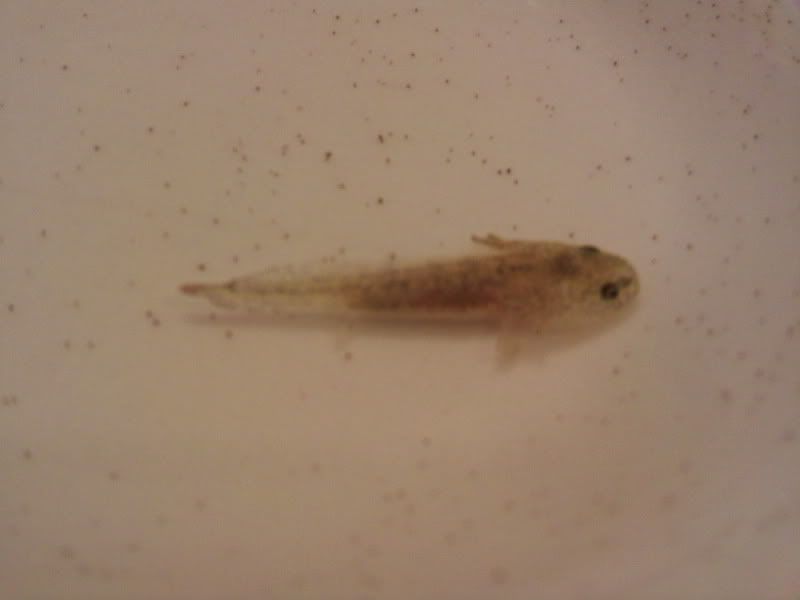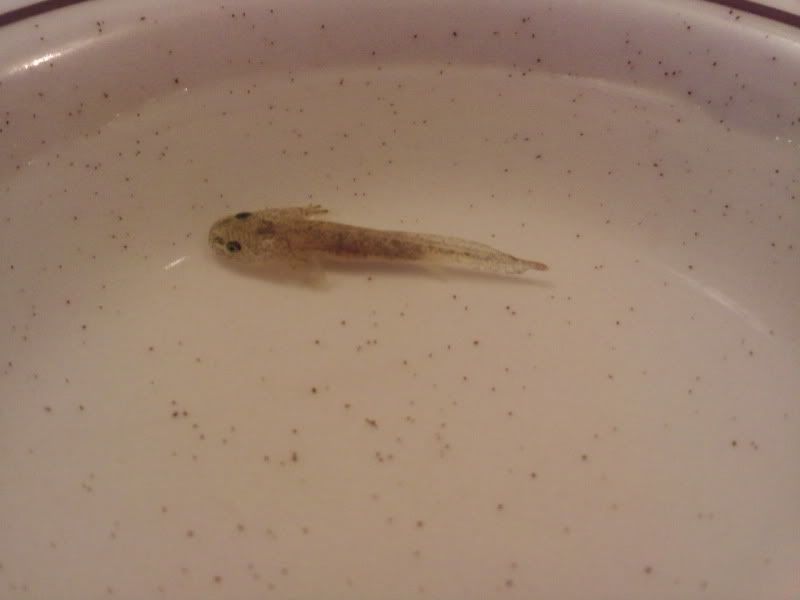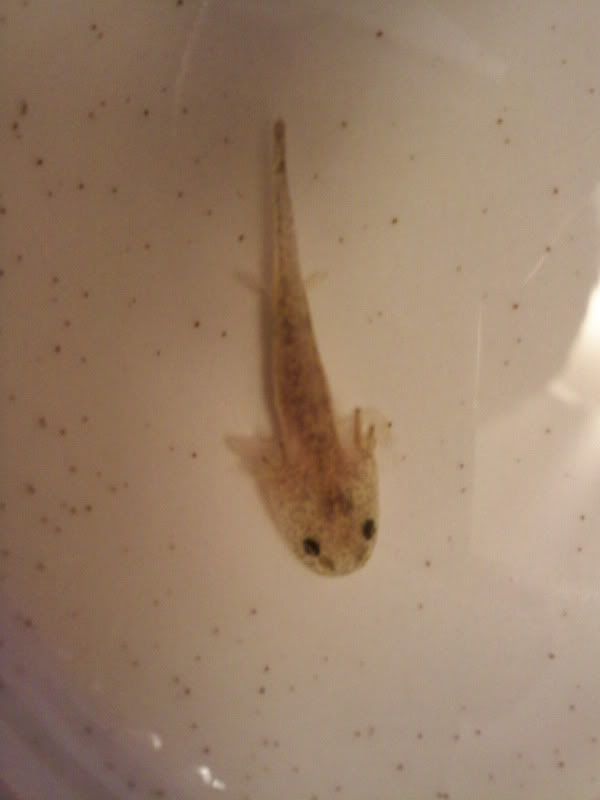Kib0y
New member
- Joined
- Dec 18, 2009
- Messages
- 45
- Reaction score
- 3
- Points
- 0
- Location
- Western New York
- Country
- United States
My developmental class is finally done for the semester and my professor gave away the experimental subjects (weeks old, green axolotl) for free, as pets. Here is the situation
I picked up my little guy healthy with a full belly (he was being fed live bryne shrimp) on Monday, December 14th (4 days ago). I put him in a 1 gallon tank with distilled water that I got from the biology department (I know it is distilled because I'm a research student there, so the source is good). I would say the little guy is roughly an inch in length. He was doing fine. I had a little problem trying to feed him small chunks of steak, so I switched him to frozen blood worms on Wednesday because it was clear he was hungry, just afraid of the tweezers I was using to try and feed him. He ate fine on Wednesday. I went to feed him yesterday and he seemed to be eating fine but I noticed he was snatching at the worms and them splitting them back out. I didn't take any consideration to this as sometimes it is normal, I read. I clean up the tank everytime after feeding as best as possible. The temperature of the water is currently 69 degrees F is stays roughly around that temperature most of the time.
So this morning I noticed the tank was getting a bit cloudy and I don't have a filter for my tank as I'm just trying to grow him to a good size to switch him into a 10 gallon tank with all the proper aeration and filtration. So I went back to my lab at the biology department and switched the old cloudy water out with fresh new distilled water. I changed the entire water supply in the tank, which I know now is a bad thing to do. However, I (and me being an idiot) cleaned out the tank with dish soap (Dawn). I rinsed out the tank three times with tap water and then three more times with distilled water to make sure of no residue before refilling up the tank. I know now that if there are any residues left from cloudiness to just use a paper towel on the edges lol. Anyway, I left him in my lab for roughly two and half hours because I was taking my last final of the semester. He was fine when I left him... I come back to him at the surface of the water with his gills curled up and shorten. I noticed his tail toward the tip was curling as well. He hasn't eaten since.
So today I thought maybe because he was used to being fed on bryne shrimp that I would try and go with that. I bought bryne shrimp to feed him but still no luck. I had my developmental teacher add some water to the tank with ions and minerals and he thought maybe it could be that it the pure water stripped him of the minerals he needs. Still no luck. I am observing him now and he's not moving much, just staying at the surface of the water. I am now seeing a new symptom... and it's been roughly 16 hours since I changed the water. His right arm is kinked inward underneath his body and he had two perfectly fine limbs. He also just keeps rocking back and forth in the water. Earlier he couldn't stay at the bottom of the tank. His tail end would keep rising and he looked like he was doing a head stand and then fall over on his back before readjusting himself, probably just air bubbles. He's very sluggish right now and only responds if I poke him (with tweezers) pretty hard as he doesn't seem startled by them.
Here's the catch though: I got another axolotl (roughly same in size) from the department just as a control (to see if it's the environmental conditions) and he ate the same food I tried to feed the unhealthy axolotl today. He hasn't shown any signs yet of sickness but it's only been roughly 12 hours since I introduced him to the tank. He hasn't been doing anything unusual in the tank but coming up for air a couple times during the day. He is swimming fine and is staying at the bottom of the tank without grabbing any air bubbles when he comes up for air.
Is there anything I should be concerned about for these axolotls (I plan on keeping the newest addition if it is possible)? Is there anything I can do to try and better his health?
Thanks in advance! I hope I was detailed enough to try and get better answers.
I picked up my little guy healthy with a full belly (he was being fed live bryne shrimp) on Monday, December 14th (4 days ago). I put him in a 1 gallon tank with distilled water that I got from the biology department (I know it is distilled because I'm a research student there, so the source is good). I would say the little guy is roughly an inch in length. He was doing fine. I had a little problem trying to feed him small chunks of steak, so I switched him to frozen blood worms on Wednesday because it was clear he was hungry, just afraid of the tweezers I was using to try and feed him. He ate fine on Wednesday. I went to feed him yesterday and he seemed to be eating fine but I noticed he was snatching at the worms and them splitting them back out. I didn't take any consideration to this as sometimes it is normal, I read. I clean up the tank everytime after feeding as best as possible. The temperature of the water is currently 69 degrees F is stays roughly around that temperature most of the time.
So this morning I noticed the tank was getting a bit cloudy and I don't have a filter for my tank as I'm just trying to grow him to a good size to switch him into a 10 gallon tank with all the proper aeration and filtration. So I went back to my lab at the biology department and switched the old cloudy water out with fresh new distilled water. I changed the entire water supply in the tank, which I know now is a bad thing to do. However, I (and me being an idiot) cleaned out the tank with dish soap (Dawn). I rinsed out the tank three times with tap water and then three more times with distilled water to make sure of no residue before refilling up the tank. I know now that if there are any residues left from cloudiness to just use a paper towel on the edges lol. Anyway, I left him in my lab for roughly two and half hours because I was taking my last final of the semester. He was fine when I left him... I come back to him at the surface of the water with his gills curled up and shorten. I noticed his tail toward the tip was curling as well. He hasn't eaten since.
So today I thought maybe because he was used to being fed on bryne shrimp that I would try and go with that. I bought bryne shrimp to feed him but still no luck. I had my developmental teacher add some water to the tank with ions and minerals and he thought maybe it could be that it the pure water stripped him of the minerals he needs. Still no luck. I am observing him now and he's not moving much, just staying at the surface of the water. I am now seeing a new symptom... and it's been roughly 16 hours since I changed the water. His right arm is kinked inward underneath his body and he had two perfectly fine limbs. He also just keeps rocking back and forth in the water. Earlier he couldn't stay at the bottom of the tank. His tail end would keep rising and he looked like he was doing a head stand and then fall over on his back before readjusting himself, probably just air bubbles. He's very sluggish right now and only responds if I poke him (with tweezers) pretty hard as he doesn't seem startled by them.
Here's the catch though: I got another axolotl (roughly same in size) from the department just as a control (to see if it's the environmental conditions) and he ate the same food I tried to feed the unhealthy axolotl today. He hasn't shown any signs yet of sickness but it's only been roughly 12 hours since I introduced him to the tank. He hasn't been doing anything unusual in the tank but coming up for air a couple times during the day. He is swimming fine and is staying at the bottom of the tank without grabbing any air bubbles when he comes up for air.
Is there anything I should be concerned about for these axolotls (I plan on keeping the newest addition if it is possible)? Is there anything I can do to try and better his health?
Thanks in advance! I hope I was detailed enough to try and get better answers.



